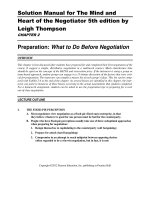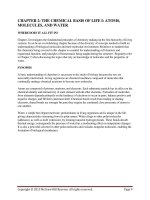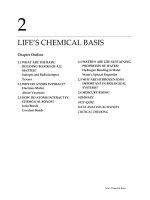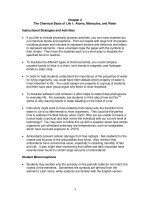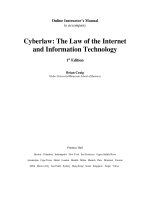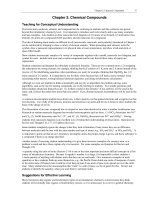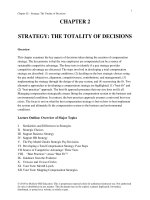Solution manual of the chemical basic of live
Bạn đang xem bản rút gọn của tài liệu. Xem và tải ngay bản đầy đủ của tài liệu tại đây (26.34 KB, 4 trang )
Chapter 2
The Chemical Basis of Life I: Atoms, Molecules, and Water
Instructional Strategies and Activities
•
If you like to include physically dynamic activities, you can have students act
out chemical bonds and reactions. Print out sheets with large font characters,
including plusses and minuses to represent protons and electrons and letters
to represent elements. Have volunteers tape the paper with the symbols to
their chests. Then have the students work out a short play to illustrate the
specified bond or reaction.
•
To illustrate the different types of chemical bonds, you could compare
covalent bonds to links in a chain, ionic bonds to magnets, and hydrogen
bonds to static cling.
•
In order to help students understand the importance of the properties of water
for living organisms, you could have them debate which property of water is
most important to life. You could assign one property to a group of students
and then have each group argue why theirs is most important.
•
To illustrate adhesion and cohesion it often helps to relate these phenomena
to everyday life. For example, ask students to think about how Jet DryTM
works or why waxing results in water beading on the hood of a car.
•
Instructors might want to have students think about why the transition from
water to ice is so detrimental to most organisms. This could be the perfect
time to address the Walt Disney urban myth! Why are we unable to freeze a
human body (cryonics) and later revive the individual with our current level of
technology? You may wish to follow this up with a question about how certain
organisms can withstand extremely low temperatures, such as tardigrades
which have survived exposure to -272°C.
•
Antioxidants prevent cellular damage from free radicals. Ask students for the
names and sources of the antioxidants they know. Also mention that
antioxidants have commercial value, especially in retarding rancidity of fats
and oils. It also might bear mentioning that coffee and dark chocolate have
recently been found to contain large amounts of antioxidants!
Student Misconceptions
•
Students may wonder why the symbols on the periodic table do not match the
names of the elements. Sometimes the symbols are derived from the
element’s Latin name, while students are familiar with the English version.
4
Some examples include:
Symbol
Au
Na
K
Latin Name
Aurum
Natrium
Kalium
English Name
Gold
Sodium
Potassium
•
Often students equate pH with a scale of acidity, and draw the erroneous
conclusion that higher numbers on the pH scale mean greater acidity. Make
sure that students understand that the pH scale is a quantitative measure of
both acidity and alkalinity of solutions by measuring the hydrogen ion
concentration. This might be a good time to review scientific notation with
your students. By seeing that 10-11 is a smaller number (thus fewer hydrogen
ions) than 10-2, a student may understand what the 11 and 2 represent on the
pH scale.
•
You may also wish to stress the logarithmic nature of the pH scale. Students
have a hard time understanding that a one point change on the pH scale
indicates a tenfold change in hydrogen ion concentration.
Beyond the Book
•
If the nucleus of an atom was the size of a marble, then the body of the whole
atom would be approximately the size of a football field, with slight variations
based on the number of subatomic particles.
•
Not only are radioisotopes used for biological research and medical
procedures, they are also utilized for industrial purposes. Radioisotopes can
function as energy sources for spacecraft and pacemakers, as well as
functioning like large x-ray machines to search for structural flaws in largescale equipment.
•
Sodium is a metal that is very reactive with water. In fact, the hydrogen
produced when sodium interacts with water can ignite from the heat released
by the reaction. However, when combined with chlorine (a toxic gas), it forms
a mineral that is almost 80% of the constituents of saltwater.
•
Although hydrogen, nitrogen, carbon and oxygen make up nearly 95% of the
atoms in living organisms, some of these elements are not so common on
Earth. Carbon only makes up 0.025% of the Earth’s crust by weight, while
hydrogen is only 0.44%. However, hydrogen is the most abundant element in
the galaxy, and nitrogen is the sixth most abundant cosmic element.
5
Additional Web Resources
•
WebElementsTM Periodic Table – Students can click on an element to be
taken to a webpage with information on the element. This site also provides a
scholar version geared towards university-level students.
/>
•
pH Scale – Animated pH scale that provides a visual illustration of the
molecules in a neutral solution and a sliding scale of pH.
/>
•
Cn3D – Free software from NCBI for viewing molecular structure in 3D, and
includes verbal summary of structural features.
/>
•
World Index of Molecular Visualization Resouces – A website devoted to
collecting links to available molecular visualization and modeling sites. Links
are sorted by author, title or subject.
www.molvisindex.org
•
USGS Water Science for Schools – A USGS site that includes the properties
of water, common measuring techniques and the Earth’s water cycles.
/>
Etymology of Key Terms
amphi-
two; both (from the Greek amphi- on both sides)
ana-
up; back (from the Greek an- up)
cat-
down (from the Greek kata- down)
colligative
depending upon the number of molecules not the specific type
(from the Latin colligatus- tying together)
hydro-
of, or pertaining to, water (from the Greek hydor- water)
ion
an electrically charged atom or group of atoms (from the Greek iongoing)
electro-
pertaining to or involving electricity (from the Greek electronamber)
equi-
equal (from the Latin aequus- equal)
-gen
that which produces (from the Greek genes- born or produced)
6
libri
balance (from the Latin libra- balance)
lys (lysis)
dissolution; breaking (from the Greek lysis- dissolution)
neutro-
neutral; having no charge or affiliation (from the Latin neuterneither)
-pathic
feeling; suffering (from the Greek pathos- suffering or feeling)
proto-
first (from the Greek protos- first)
radio-
dealing with radiant energy; emitting rays (from the Latin radiusray)
solute
substance dissolved in a solution (from the Latin solutus, past
participle of solvere- to loosen)
solvent
a substance that dissolves another to form a solution (from the
Latin solvent, the stem of solvens, which is the present participle of
solvere- to loosen)
7
